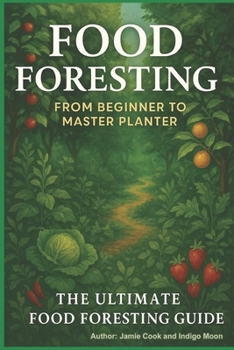Food Foresting From Beginner to Master Planter: The Ultimate Food Foresting Guide
Food Foresting
From Beginner to Master Planter
The Ultimate Food Foresting Guide
Chapter 1: Food Foresting - Changing the World
If there were one solution that could heal the soil, reverse climate change, restore communities, sequester carbon, purify water, save pollinators, end deforestation, return autonomy to people, and reconnect us with the divine rhythms of the Earth - would we do it?
The answer is yes. Food foresting is that solution.
Food foresting is the design and planting of multi-layered, self-sustaining ecosystems that mimic natural forests - but with one difference: nearly everything in the system feeds or nourishes human beings, animals, and the Earth simultaneously. Unlike conventional agriculture, which relies on single crops, chemicals, irrigation, and replanting each season, food forests are perennial systems. They grow stronger each year, produce more with less effort, and regenerate soil, water, and life as they grow.
This is not a concept. It is already transforming land, lives, and entire communities around the world. And here's how: Would you prefer a lawn to mow, or a yard that feeds you - and possibly so much extra you have food to give away?
Food forests produce continuous, renewable nutrition from every layer of a living system.Trees produce fruit, nuts, and seeds every year.Shrubs give berries, herbs, and greens.Ground covers offer root vegetables and nitrogen-fixing support.Mushrooms grow in shaded areas.Vines bring grapes, beans, gourds, and squash.Instead of one crop per year, food forests offer multiple harvests, across multiple layers, with less maintenance and more diversity. They grow where you live - on your land, in your yard, in your neighborhood - and they belong to you.
From Beginner to Master Planter
The Ultimate Food Foresting Guide
Chapter 1: Food Foresting - Changing the World
If there were one solution that could heal the soil, reverse climate change, restore communities, sequester carbon, purify water, save pollinators, end deforestation, return autonomy to people, and reconnect us with the divine rhythms of the Earth - would we do it?
The answer is yes. Food foresting is that solution.
Food foresting is the design and planting of multi-layered, self-sustaining ecosystems that mimic natural forests - but with one difference: nearly everything in the system feeds or nourishes human beings, animals, and the Earth simultaneously. Unlike conventional agriculture, which relies on single crops, chemicals, irrigation, and replanting each season, food forests are perennial systems. They grow stronger each year, produce more with less effort, and regenerate soil, water, and life as they grow.
This is not a concept. It is already transforming land, lives, and entire communities around the world. And here's how: Would you prefer a lawn to mow, or a yard that feeds you - and possibly so much extra you have food to give away?
Food forests produce continuous, renewable nutrition from every layer of a living system.Trees produce fruit, nuts, and seeds every year.Shrubs give berries, herbs, and greens.Ground covers offer root vegetables and nitrogen-fixing support.Mushrooms grow in shaded areas.Vines bring grapes, beans, gourds, and squash.Instead of one crop per year, food forests offer multiple harvests, across multiple layers, with less maintenance and more diversity. They grow where you live - on your land, in your yard, in your neighborhood - and they belong to you.
Format:Paperback
Language:English
ISBN:B0FK5M8C51
ISBN13:9798294452865
Release Date:July 2025
Publisher:Independently Published
Length:212 Pages
Weight:0.64 lbs.
Dimensions:0.5" x 6.0" x 9.0"
Customer Reviews
0 rating





